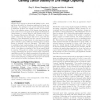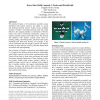1243 search results - page 232 / 249 » Towards Computer Understanding of Human Interactions |
BMCBI
2007
13 years 7 months ago
2007
Background: Biomolecular networks dynamically respond to stimuli and implement cellular function. Understanding these dynamic changes is the key challenge for cell biologists. As ...
ICARCV
2008
IEEE
14 years 2 months ago
2008
IEEE
Digital colour cameras are dramatically falling in price, making them affordable for ubiquitous appliances in many applications. An attempt to use colour information reveals a si...
ICMI
2004
Springer
14 years 1 months ago
2004
Springer
Perhaps the most fundamental application of affective computing would be Human-Computer Interaction (HCI) in which the computer is able to detect and track the user’s affective ...
CHI
2004
ACM
14 years 1 months ago
2004
ACM
We introduce Topobo, a 3D constructive assembly system embedded with kinetic memory, the ability to record and playback physical motion. Unique among modeling systems is Topoboʼs...
CHI
2011
ACM
12 years 11 months ago
2011
ACM
As HCI is applied in increasingly diverse contexts, it is important to consider situations in which computational or information technologies may be less appropriate. This paper p...




